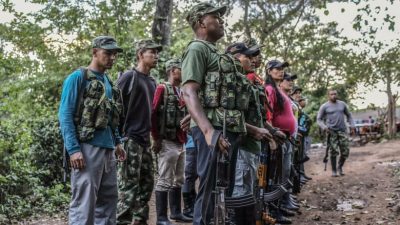Drug Trafficking Militias Massacre Social Leaders in Colombia

In Colombia, a terrible wave of violence affects the people and especially traditional indigenous communities. According to United Nations data, more than 40 murders of social leaders have occurred this year alone.
Last Tuesday, August 18, three Indians of the Awá people were murdered in the municipality of Ricaurte, department of Nariño, while two young men were tortured and murdered in El Patía, department of Cauca, and a social leader, Jaime Monge, was also murdered in Villacarmelo, a rural area of Cali. These deaths made newspapers’ headlines a few days after others that shocked the country. On Saturday, 15, eight young men were shot in the municipality of Samaniego; on the 11th, five teenagers were murdered in Llano Verde and an Afro-Colombian social leader was murdered in Chocó; and on the 8th, in the municipality of Leiva, Nariño, two students who were attending school were murdered.
Contrary to what was common in other times, there is no public claim of responsibility for the murders. The main reason for this is that currently there is no longer a monopoly on the attacks by the major illegal factions, but the simultaneous action of a wide variety of militias involved in drug trafficking networks. However, the Colombian State denies the existence of widespread paramilitarism in the country. Whenever a massacre occurs in the country, the official versions generally point to drug trafficking as the culprit, without further investigation, which is why the attacks remain unpunished.
Despite the denials of the authorities, the existence of multiple groups is evident and the phenomenon of paramilitarism can no longer be associated strictly with groups such as the FARC (Revolutionary Armed Forces of Colombia) and the ELN (National Liberation Army), being, currently, an extremely multifaceted and widespread phenomenon. For example, in three recent massacres in the Santander region, a paramilitary group known as “Los Rastrojos” was denounced as the perpetrator. According to local sources, this group has between 150 and 200 members and is advancing across the country.
This same armed group – “Los Rastrojos” – has an interesting history of links with drug trafficking in the neighboring country, Venezuela. The group was expelled from Venezuela due to the constant and incisive actions of Venezuelan security forces, which forced the migration of militia members to Colombia, where they are now spreading with great speed. However, “los Rastrojos” act not only in drug trafficking, but also in politics, apparently. It was this group that, in February 2019, accompanied Juan Guaidó’s flight to Colombia. Guaidó, moreover, has several records in photos and videos with members of the militia, which raises suspicions of links between the Venezuelan opposition and Colombian drug trafficking.
In fact, the peace agreement signed between the Colombian government and the FARC in 2016 did not end civil conflicts, but it did generate a reconfiguration of the actors in the fighting. Now legalized, the FARC is no longer the main belligerent group and new, lesser-known militias are taking on a greater role in drug trafficking. In practice, the power of these militias far outweighs the ability of state security forces to control and combat them, which spurs the creation of secret networks of cooperation between the state and organized crime to keep illegal activities “restricted” and avoid the liquidation of the social order. In this way, rises what we can call a narco-state – a phenomenon in which people and criminal organizations involved in drug trafficking start to occupy positions of relevance in the government and to influence state policies.
The existence of a Colombian Narco-State is almost undeniable and explains the inertia of state forces to investigate crimes committed by criminal organizations. Massacres occur freely across the country as social movements and communities of traditional peoples become an obstacle to the advancement of trafficking. The State remains silent and even collaborates with the actions of the militias and thus the interests of crime are realized without any impediment.
The situation in Colombia, however, is old and the country has been referred to as a Narco-State on several other occasions. What is really surprising is not the Colombian government’s attitude towards organized crime, but the inertia of international organizations and foreign powers in the case. Still, the role of the US in South America is curious. A few months ago, US President Donald Trump accused Venezuelan President Nicolás Maduro of being involved in drug trafficking and offered a millionaire reward for his “capture”. However, the main center of US operations against Venezuela is precisely Colombia, from where, on more than one occasion, mercenaries left and crossed the border into Venezuela trying to overthrow Maduro. In addition, Washington-backed Venezuelan opposition leader Guaidó has already demonstrated links to at least one criminal organization active in Colombia and involved in the murders of social leaders.
Why do Washington, the United Nations and all the Western powers that condemn Maduro remain silent in the face of these cases? Why is Colombia not being punished with international sanctions for its inertia in preventing the massacre of its own people? Perhaps drug trafficking is not really an enemy for Washington.
*
Note to readers: please click the share buttons above or below. Forward this article to your email lists. Crosspost on your blog site, internet forums. etc.
This article was originally published on InfoBrics.
Lucas Leiroz is a research fellow in international law at the Federal University of Rio de Janeiro.
Featured image is from InfoBrics

